Poultry (turkey, duck and chicken) slaughtering and processing plants typically process 20,000 or more birds per day. The shackling, killing, scalding, and picking areas of the plant emit airborne microorganisms, moisture, and dust. These contaminants are unwanted in the processing and packing areas of the plant because they can affect product quality and safety. They also pose a potential threat to the health and well-being of the workers in the plant.
Typical Ventilation Systems
Poultry slaughtering plants are typically ventilated with negative-pressure systems. Most of the air moving capacity is provided by large roof fans above the scalding and picking equipment. The balance of the air is moved with local exhaust fans in other locations. This ventilation strategy is based on the theory that fresh air will flow one-way from relatively clean meat cutting and packaging operations to locations with bioaerosol (bacterial pathogens and spoilage microorganisms) emission and finally to the exhaust fans, Figure 1. However, they do not always achieve this desired airflow pattern. The following aspects of the ventilation system are critical for achieving the desired airflow pattern.
Fresh Air Intakes
The distribution of air in any ventilated room depends on the size and location of ventilation intakes. In a poultry plant, many rooms are ventilated with air entering and leaving wall openings, Figure 1. These wall openings consist of shackle line openings and doorways. Shackle line openings are for transfer-ring product from one processing operation to another. Doorways are for the convenience of worker and vehicle traffic. Room ventilation is apparently not considered when these wall openings are located. However, their sizes and locations have a significant impact on room air distribution.
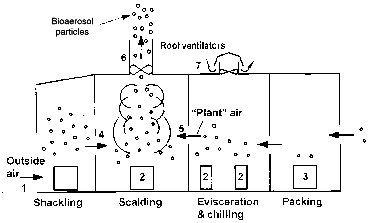
Figure 1. Schematic of air movement in a poultry slaughtering
plant.
With a negative pressure system, air leaks into the room around doorways and other unplanned openings. Many doors in poultry plants consist of double doors, large garage doors, doors to walk-in coolers, and shipping/receiving docks. These large doors can have crack areas with up to 500 cfm flowing through them. Cold air leaking into a room due to negative pressure makes occupants uncomfortable and can cause considerable condensation and frost as warm moist air mixes with weak cold air jets nd contacts cold surfaces. The plant's largest exhaust fans are located in relatively small picking and scalding rooms and move about 12,000- to 50,000- cfm. These fans create a large negative static pressure that draws in air from all openings to the room. Much of the air flows inward from the line openings to the outside shackling area, typically 30 to 90% of the exhaust airflow. The rest of the air comes in from the plant, Figure 1. The overall room air balance is influenced by the size of he openings to the room. More air could be drawn through the plant if the openings into the shackling area were reduced and the openings to the evisceration room were enlarged. Consult a ventilation engineer for help in determining best opening sizes.
Arbitrary Modifications
The original ventilation system for a poultry processing plant is sometimes modified as rooms are added for more processing capacity. Additionally, exhaust fans are sometimes added in attempts to eliminate condensation. These exhaust fans can move air opposing the main exhaust fans in the picking and scalding rooms. Air movement from clean areas to bioaerosol emission sources can be reversed if enough fans are added.
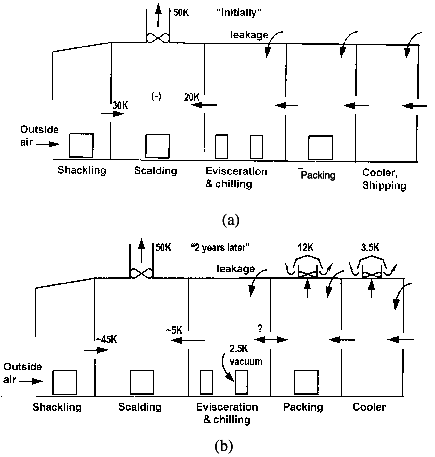
Figure 2. Hypothetical plant: a) before, and b) after arbitrary
modifications to the ventilation system.
Hypothetical Example
A plant has three fans in the scalding room with a total capacity of 50,000 cfm, Figure 2a. However, 30,000 cfm is drawn through large line openings from the outdoor shack-ling area which is immediately adjacent to the scalding room. The remaining 20,000 cfm is drawn through line openings from the eviscerating room. Therefore, the original design causes 20,000 cfm to flow through the plant from the processing rooms to the eviscerating area and then to the scalding and picking room. A year later, the plant adds three, 4,000 cfm fans in the packaging room to eliminate moisture, and prevent condensation occurring on the ceiling. Two years later, new vacuum sources requiring 2,500 cfm are added to the processing areas, Figure 2b. Also, a 3,500 cfm exhaust system is added to a cooler room to remove carbon dioxide.
After these modifications, 18,000 cfm are exhausted at other locations besides the picking and scalding rooms. A major portion of this air comes from the evisceration room thus producing some reverse flow in the plant and causing an even greater portion of the air to flow into the picking and scalding rooms from the shackling area, Figure 2b. Fan Maintenance The fans and intakes in poultry meat plants are above the roof line and are easily ignored because most of the attention is given to t e operation on the floor ("out of sight, out of mind"). However, fan capacity can be reduced by up to 50% when the guards and backdraft shutters are laden with dust and feather material. Intakes can become completely plugged by particulate emissions from nearby exhaust fans. Ventilation equipment maintenance should be a routine task of the plant maintenance crew.
Multi-Purpose Rooms
Air distribution should be taken into consideration when laying out processes within the room. Sometimes, "clean operations" for final product such as cutup and packaging are conducted in the same room as "dirty operations" such as evisceration. The "dirty operations" closer to the raw receiving area emit bioaerosols that can move to and deposit onto clean product. Thus, room air distribution is very important in preventing unnecessary food contamination.
Fan Mismatches
A food manufacturing plant may have several types and sizes of fans exhausting from the same room or adjoining rooms. High-pressure power ventilators, tube-axial fans, centrifugal fans, and vacuum systems sometimes operate in parallel with low-pressure propeller fans. As a consequence, weaker exhaust fans operate at reduced efficiency and air flow. Also, relatively moist air condenses on the inside of fan housings as air flow decreases. Additionally, air flow from areas with contamination sources to clean areas such as meat packaging may be created due to reverse flow. This increases product contamination and decreases food safety. In one case, about 5,000 cfm of air actually reversed through a large, belt-driven, exhaust fan running at slow speed in a feather wash room, Figure 3. This occurred because, in addition to strong exhaust fans in adjoining rooms, a furnace with a high speed centrifugal fan exhausted air from the same room and blew hot air into the adjoining rooms via ductwork. The negative static pressure created by the furnace fan was felt by the slow moving fan as excessive back pressure. The airflow through the weak exhaust fan became positive again after the furnace was shut off. To correct this situation, weak fans should be replaced with stronger or higher pressure fans. Or the speed of the weak fan should be increased. In this particular case, the supply air for the furnace could have been taken from another room.
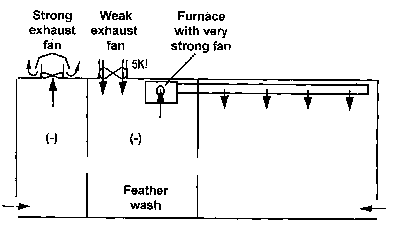
Figure3. Example of fan mismatch in feather wash room.
Effects of Wind Pressure
Wind blowing into a large opening such as open doors or windows can pressurize a room causing undesired flow of air. In one case, air flowed through door cracks and other openings from a compressor and refrigeration room into a meat processing room when an overhead door was opened to "cool the compressors," Figure 4a. The door was opened to an oncoming 12 mph wind even though the compressor room had its own exhaust ventilation system. Upon shutting the overhead door, the pressure in the compressor room became negative compared to that of the processing room and air flowed from the processing room to the compressor room, as desired, to keep contaminants away from clean product, Figure 4b.
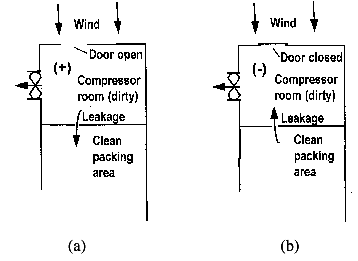
Figure4. Effect of wind pressure on leaks into clean product
area of the plant with garage door open (a) and closed (b).
In another case, an overhead door in the picking room facing an 8-mph wind was opened on a hot summer day, Figure 5a. The resulting 18,000 cfm of air flowing inward through this door created high humidity and airborne microbial concentrations in the adjoining evisceration and processing room. The picking room was equipped with large exhaust fans, but the wind pressurized the "dirty" room in such as a way as to induce airflow into the "clean" room through some of the line openings between the two rooms, Figure 5a. Shutting the overhead garage door allowed the exhaust fans to create the negative pressure required to draw air through all openings from the evisceration and packing room, Figure 5b.
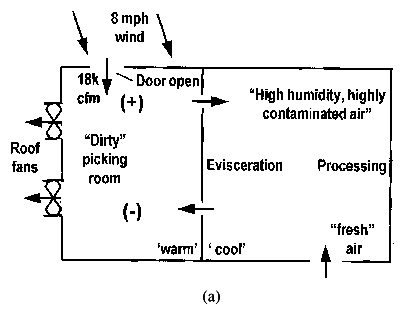
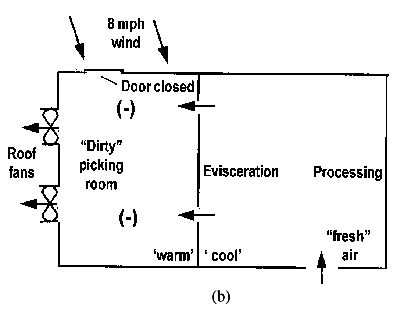
Figure 5. Effect of wind pressure on airflow between dirty
and clean rooms with garage door open (a) and closed (b).
Summary
The emission of airborne particles with pathogenic and spoilage microorganisms in poultry slaughtering and processing plants can create high airborne concentrations. It is important to keep these unwanted bioaerosols from processing and packing areas to assure product quality and safety and the health and well-being of plant workers. The design of ventilation systems is challenging because large airflows occur through shackle line openings between rooms and from the outdoors. However, careful design and maintenance of the ventilation system can prevent migration of airborne contamination from reaching clean areas of the plant.
Cooperative
Extension work in Agriculture and Home Economics, state of Indiana,
Purdue University, and U.S. Department of Agriculture cooperating;
H. A. Wadsworth, Director, West Lafayette, IN. Issued in furtherance
of the acts of May 8 and June 30, 1914. The Purdue University
Cooperative Extension Service is an equal opportunity/equal
access institution.
A.J. Heber, Department of Agricultural and Biological Engineering
N.J. Zimmerman, School of Health Science
R. H. Linton, Department of Food Science
NEW 8/95 (.75M)
Disclaimer and Reproduction Information: Information in NASD does not represent NIOSH policy. Information included in NASD appears by permission of the author and/or copyright holder. More